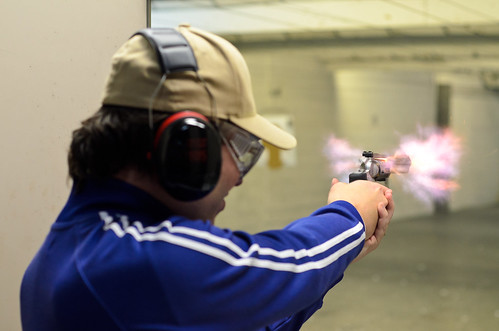Overview of .38 Special and .32 Caliber
First of all, let us throw in there that .38 special was initially designed by Smith & Wesson in 1898. It has been widely spread and known as something that always works and is very effective for defense purposes, by police officers and private individuals alike. Since its introduction, many police officers have used this caliber to stopping a great number of offenders, often permanently if you know what I mean.
The .38 Special is a rimmed cartridge for revolvers that usually propels a bullet with a weight between 110 and 158 grains. The .38 Special is also widely recognized as a versatile cartridge and manufacturers produce it in several loadings, including standard pressure and +P (increased pressure) options that help its performance. Besides, these loadings come in various forms such as hollow-points, semi-wadcutters, or even wadcutters (a type of bullet that is surprisingly effective in defense) and so on.
Now on to the .32 caliber, mainly such cartridges as the .32 ACP (Automatic Colt Pistol) and .32 H&R Magnun. The .32 ACP is a semi-automatic cartridge, while .32 H&R Magnum is the revolver cartridge that provides higher speed and more power than .32 ACP. The .32 caliber generally launches lighter bullets, usually weighing 60-100 grains. To be frank, intelligent guys often eschew both of the previous loads and just go with .32 SW Long caliber (old-timer round, it’s true) and wadcutters in the defense lightweight revolvers.
Ballistics and Stopping the Bad Guy Power
When faced with a bad guy who is coming at you in a charge, ballistics and stopping power are, to say the least, very important factors. The .38 Special is generally associated with stopping power and the most famous example is its +P loads.
A standard .38 Special cartridge can have a velocity of about 800-900 fps and a muzzle energy of around 200-300 ft-lbs. Depending on the barrel length (say, 4 inches and longer [get your head out of the gutter]), this is more than enough to safely expand self-defense hollowpoint ammo. However, with shorter barrels, maybe go with a lead roundnose or wadcutter; although they will likely not expand, they will still go through the recommended 12+ inches of tissue to reach the internal organs and tissues thus, stopping the criminal(s) easily.
On the other hand, the .32 ACP generally reaches a velocity of 900-1000 fps and a muzzle energy of 100-200 ft-lbs, while the .32 H&R Magnum can go up to 1,000-1,200 fps, and the energy released is about 200-300 ft-lbs. The hitch, nonetheless, is that the bullet is in almost all cases smaller and lighter; therefore, they’ll tear and shred the bad guy’s insides less than a wider-caliber bullet, esp. if the resultant penetration is less than a .38 Special.
It is generally accepted that the .38 Special is a king of non-magnum stopping power due to its heavier bullets and larger energy output. However, a .32 caliber gun can be very efficient in self-defense situations, especially when it uses good hollow point ammunition meant for expansion (and again, like with .38, you’ll need a sufficiently long barrel; otherwise, .32 wadcutters are good for penetration).
Recoil and Shootability
Recoil is an important factor in the choice of a self-defense firearm, because it can influence precision and the ability to perform follow-up shots, which is very important if you are not a person surnamed Earp or Oakley. The .38 Special, especially in +P versions, can generate a noticeable kick, which might be a problem for some shooters, particularly those who are not good at shooting or have less upper body strength.
Recoiling of the .38 revolvers can be softened by grips, the lighter design of the revolvers, and the use of ammunition that is not of high pressure. You will hardly feel the recoil if you decide to go for light loads, like the aforementioned wadcutters, instead of using +P loads.
On the other hand, the .32 caliber, specifically the .32 ACP in semi-autos, is usually associated with lower recoil which makes shooting more accurate and faster. This feature can be especially handy for individuals who are prone to recoil, like new shooters, some young men, some women, or those with physical limitations. The small kickback of the .32 caliber will allow you to concentrate on the next shot, and this is the main factor in any self-defense situation.
A quick note and personal story: I have both a lightweight revolver .38 Special and a .327 Federal Magnum. While shooting light wadcutters from both (.32 SW Longs in the second revolver), I don’t feel that the recoil is significantly lower in .32 calibers. They felt equally in recoil. Take it for what it’s worth. However, I had six rounds of ammunition available for the .327 Federal Magnum revolver and only five for the .38 Special, so this certainly is a difference here.
Firearm Options
The appropriate firearm is as well that changes the result when one is comparing .38 Special and .32 caliber for self-defense. The .38 Special is a revolver by the nature of the beast. The revolver is noted for its reliability and simplicity, and those are the features it is known for.
Many revolvers designed for .38 Special are compact and easy to conceal, thus they become the most favorite among the concealed carry users. The Smith & Wesson J-Frame and Ruger LCR models are among the lightweight options which can be easily concealed. I am carrying a Smith & Wesson 642 Performance Center, personally.
On the other hand, .32 calibre can be found not only in revolvers but also in semi-automatic pistols. The .32 ACP is almost always in a semi-auto, which are perfect for concealed carry (just ask the guy who shot the Archduke).
Therefore, if you’re not the type of person who gets all overwhelmed by an abundance of choices, then the best thing you can do is to simply ask yourself what kind of choices would suit you.
Ammunition Availability and Cost
If you don’t have the last name Rockefeller, then cost (and availability) is going to be extremely important for you. The .38 Special is produced by numerous manufacturers and it is very widespread. Generally, .38 Special ammo is cheap, but the prices depend on the conditions of the market, which means that they, along with .32 calibers, may cause some fluctuation.
The .32 caliber, although it was available, may not have been as commonly stocked in every gun shop. Some shooters could have had more difficulty in finding specific self-defense loads in .32 caliber than others. Besides, the price of .32 ammunition is not fixed, and in almost all situations, it can be higher than that of .38 Special because of lower production volumes.
So…Which One Is It?
The choice between .38 Special and .32 caliber for self-defense is frankly a matter of the person’s own preferences, needs, and comfort.
When deciding on a self-defense handgun and caliber, it is extremely and extremely important to consider factors such as personal comfort, shooting proficiency, and the specific context in which the firearm will be used. In the end, the .38 Special and the .32 calibers are both great self-defense choices so that you do not have to worry about either of them being an incorrect one. The absolute BEST choice, though, still relies on what you prefer and what kind of dangerous situations you expect to be in.
In my case, I am fond of carrying revolvers because of their simplicity. I have both the S&W 642 and also a Ruger LCR chambered in .327 Federal Magnum, and actually, I almost always carry the .38 Special 642.
Good luck to ya!


